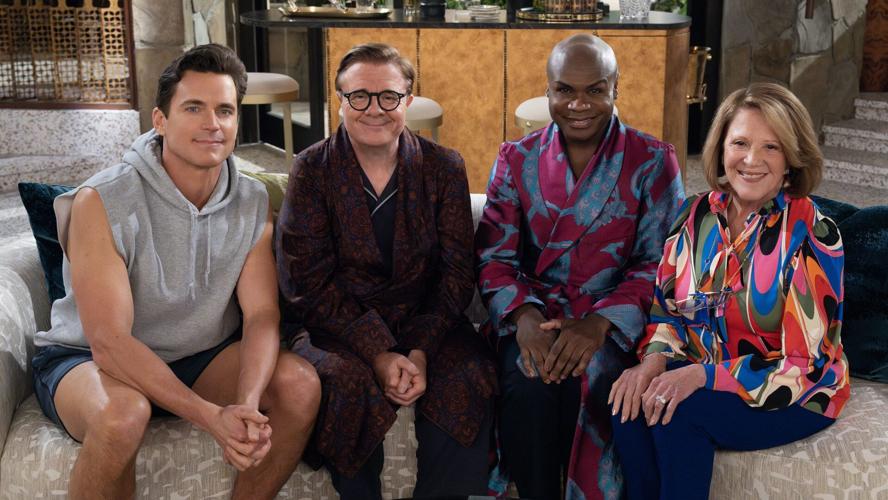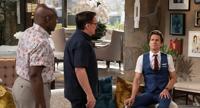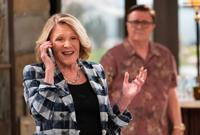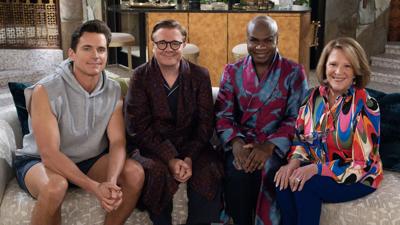If you were a fan of NBC's Will & Grace (1998), you might have an interest here. It's now one of the rare, multi-camera sitcoms to be produced now. Since the success of The Office (2005), multi-camera or what's known as traditional sitcoms aren't really produced anymore. Certain networks like CBS, which produced them in abundance, has scaled back, which makes this series a definite throwback to the 90's in terms of style and tone. However, the premise of this series is an even further throwback because the template here is unabashedly a rip-off of The Golden Girls (1985), which has been stereotypically called the best gay series, not featuring gay men. The second in that regard is Sex and the City (1998). The premise of that 1985 classic is that four retired women decided to live together and spend their retirement together. Sex and the City was simply about four women who were just friends that hung out together. If you're going to do a multi-camera sitcom, having all the characters live together makes sense on a production level, but when it comes to this series, I'm not sure it makes sense on a story level.
This series is about three gay men who decide to live together. In The Golden Girls, all the characters were around the same age and they were all pushing elderly status, despite all of them being vivacious and lively. Here, the characters aren't all the same age. In fact, one of the gay men is 20 years younger than the others. It's not uncommon for people, be they gay or not, to have friends who are significantly older or younger than them. It simply presents issues that this series doesn't address, at least not in this first season. If there's a second season, it should perhaps raise those concerns. Till then, this series remains simply a vehicle for exploring topics related to sexual orientation, same-sex dating, aging, family and even politics. Creators David Kohan and Max Mutchnick, who are also the co-creators of Will & Grace, bring a sharp sense of comedy, which includes a lot of zingers and one-liners where we hear the characters insulting and sniping at one another. If one is familiar with the British series Vicious (2013), which aired on PBS, one could compare it to that, but Kohan and Mutchnick don't go as hard as the writers of that British show.

Nathan Lane (The Gilded Age and The Birdcage) stars as Bunny Schneiderman, a Jewish man in his mid to late 60's who lives with his mother in Palm Springs, California. For those who don't know, Palm Springs is known for its "mid-century modern" architecture and design elements. That, and it's known for its large LGBTQ population. Palm Springs has the fifth-highest percentage of same-sex households in the nation. It also has America's first fully LGBTQ city government. Bunny owns a lingerie business that specializes in selling bras to both women and men. We never really see him doing that job, but we assume that the store is going well, given that he owns several of them.
He lives with his mother, Sybil Schneiderman, played by Linda Lavin (9JKL and Alice). Sybil is ostensibly playing the Estelle Getty role here. She's a quick-witted, no nonsense woman who has no problem insulting anyone, including and most especially her child. She loves him and seemingly prefers him over her other child, her daughter. Other than that, she's a bit of a snob. She's materialistic, requiring the finer things and luxurious items only. She's probably the funniest character in the series.

Matt Bomer (Fellow Travelers and Will & Grace) co-stars as Jerry Frank, a flight attendant who is in his 40's. If this were The Golden Girls, he would be playing the Betty White role. He's ostensibly the naive and dumb member of this group. This comes from the fact that Jerry is a former Mormon who left the religion because he's gay and knew that he wouldn't be accepted within that Mormon community. Living most of his life as a Mormon has sheltered him from a lot of things, so that accounts for his naivety and dumbness for lack of a better word. However, since he's 20 years younger than Bunny and 40 years younger than Sybil, living with them would be strange unless he sees them as surrogate parents. Yet, in Episode 4, Jerry reveals that he perhaps had romantic feelings for Bunny that has since dissipated, so I don't think Jerry sees Bunny in a fatherly way, unless there's an Oedipus complex that has yet been diagnosed.
On its face, Jerry living with Bunny and Sybil is fine and it makes sense in the short term. However, the issue might eventually arise that Jerry might get a boyfriend, which might turn into a serious relationship and Jerry might want to marry. At that point, would Jerry and his husband continue living with Bunny and Sybil? This arrangement can't possibly last. Unless Jerry and everyone else decide to remain single forever, one or more of them would eventually move out. Given how attractive Jerry is, which everyone comments, he seems like the one who would probably bow out first.

Nathan Lee Graham (Katy Keene and The Comeback) rounds out the cast as Arthur Broussard, a stylist or fashion designer. We learn that he was married or was in a long-term relationship with someone who died. He's a widower that doesn't necessarily seem like he's looking for another relationship, which is an easy way to dismiss this character as never having another romantic relationship. Obviously, there are people who truly never marry or get involved again in a long-term relationship after becoming a widow or widower. Given that Arthur is African American and given the lack of queer people of color on what would otherwise be a mainstream series, not having a Black, gay romance as even a possibility feels disappointing. Black, same-sex romance is rare and this series squanders a golden opportunity.
Obviously, Jerry gets to have various love interests or simply sex partners hop in and out. The second episode sees Jerry with a casino manager named Sal, played by Bruno Amato (Abbott Elementary and Yellowstone). In the fifth episode, we see Jerry with a fellow ex-Mormon named Mason, played by Zane Phillips (Legacies and Fire Island). Mason returns in a later episode, but Sal is rather dismissed. No explanation as to why, other than this is episodic television. Bunny gets a potential love interest in the first episode with Antonio, played by Renan Pacheco. Bunny has another strong flirtation in the sixth episode with Bo, played by Adam Hagenbuch (Fuller House and Undateable). Both Antonio and Bo are dismissed as sugar babies in order to reinforce the idea of Bunny not having a true romance when the real-life Nathan Lane does have a true romance, so the idea of it not being possible here is another disappointment.

Finally, it should be said that this series begins with a death and ends with a death. In the first episode, an unseen character named George who was the fourth friend in this Golden Girls-esque group dies. We don't get that much about him, except he was the one who dated Jerry and introduced Jerry to Bunny and Arthur. However, in the making of this series, Linda Lavin passed away in real-life, which caused the writers to write her character dying as well in the ninth episode. Her loss will probably be felt the most in the following seasons, if this series continues on. As stated, she was the best part of this series, and as her final piece of work, the series should be viewed for that alone.
Rated TV-MA.
Running Time: 30 mins. / 10 eps.
Available on Hulu.











